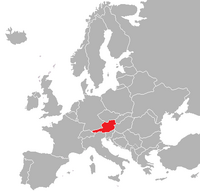Essay: The Ghost of Atheism Yet To Come

By the way, have you read the articles European desecularization in the 21st century and Future of atheism in China?

The American sociologist and author Peter L. Berger introduced the concept of desecularization in 1999.[2][3]
According to Berger, "One can say with some confidence that modern Pentecostalism must be the fastest growing religion in human history."[4] See also: Growth of pentecostalism and Growth of religious fundamentalism
The current atheist population mostly resides in East Asia (particularly China) and in secular Europe/Australia among whites.[5] See: Secular Europe and Asian atheism
Razib Khan points out in Discover Magazine, "most secular nations in the world are those of East Asia, in particular what are often termed 'Confucian societies'. It is likely therefore that the majority of the world’s atheists are actually East Asian."[6]
Professor Eric Kaufmann, who teaches at Birkbeck College, University of London, specializes in the academic area of how demographic changes affect religion/irreligion and politics. Kaufmann is an agnostic.

East Asia is expected to experience desecularization in the 21st century (see: East Asia and global desecularization).
On December 23, 2012, Kaufmann wrote:
| “ | I argue that 97% of the world's population growth is taking place in the developing world, where 95% of people are religious.
On the other hand, the secular West and East Asia has very low fertility and a rapidly aging population... In the coming decades, the developed world's demand for workers to pay its pensions and work in its service sector will soar alongside the booming supply of young people in the third world. Ergo, we can expect significant immigration to the secular West which will import religious revival on the back of ethnic change. In addition, those with religious beliefs tend to have higher birth rates than the secular population, with fundamentalists having far larger families. The epicentre of these trends will be in immigration gateway cities like New York (a third white), Amsterdam (half Dutch), Los Angeles (28% white), and London, 45% white British.[7] [8] |
” |
East Asia is expected to experience desecularization in the 21st century (see: East Asia and global desecularization and Future of atheism in China).
A study conducted by the Washington-based Pew Forum on Religion & Public Life says that Africans are among the most religious people on Earth.[9] Africa has a high fertility rate and it is seeing a big population boom. According to the Institute For Security Studies: "Africa's population is the fastest growing in the world. It is expected to increase by roughly 50% over the next 18 years, growing from 1.2 billion people today to over 1.8 billion in 2035. In fact, Africa will account for nearly half of global population growth over the next two decades."[10] See: Religion and Africa
At a conference Kaufmann said of religious demographic projections concerning the 21st century:
| “ | Part of the reason I think demography is very important, at least if we are going to speak about the future, is that it is the most predictable of the social sciences.
...if you look at a population and its age structure now. You can tell a lot about the future. ...So by looking at the relative age structure of different populations you can already say a lot about the future... ...Religious fundamentalism is going to be on the increase in the future and not just out there in the developing world..., but in the developed world as well.[11] |
” |
See also: Religion and migration and Growth of religious fundamentalism

Dr. Steve Turley wrote:
| “ | According to University of London scholar Eric Kaufmann’s detailed study on global demographic trends, we are in the early stages of nothing less than a demographic revolution. In Kaufmann’s words, "religious fundamentalists are on course to take over the world." There is a significant demographic deficit between secularists and conservative religionists. For example, in the U.S., while self-identified non-religionist women averaged only 1.5 children per couple in 2002, conservative evangelical women averaged 2.5 children, representing a 28 percent fertility edge. Kaufmann notes that this demographic deficit has dramatic effects over time. In a population evenly divided, these numbers indicate that conservative evangelicals would increase from 50 to 62.5 percent of the population in a single generation. In two generations, their number would increase to 73.5 percent, and over the course of 200 years, they would represent 99.4 percent. The Amish and Mormons provide contemporary illustrations of the compound effect of endogamous growth. The Amish double in population every twenty years, and projections have the Amish numbering over a million in the U.S. and Canada in just a few decades. Since 1830, Mormon growth has averaged 40 percent per decade, which means that by 2080, there may be as many as 267 million Mormons in the world, making them by 2100 anywhere from one to six percent of the world’s population.
In Europe, immigration is making the continent more religiously conservative, not less; in fact, London and Paris are some of the most religiously dense areas within their respective populations. In Britain, for example, Ultra-Orthodox or Haredi Jews constitute only 17 percent of the Jewish population but account for 75 percent of Jewish births. And in Israel, Haredi schoolchildren have gone from comprising a few percent to nearly a third of all Jewish pupils in a matter of five decades, and are poised to represent the majority of the Jewish population by 2050. Since 1970, charismatic Christians in Europe have expanded steadily at a rate of 4 percent per year, in step with Muslim growth. Currently, Laestadian Lutherans in Finland and Holland’s Orthodox Calvinists have a fertility advantage over their wider secular populations of 4:1 and 2:1 respectively. In contrast, Kaufmann’s data projects that secularists, who consistently exemplify a low fertility rate of around 1.5 (significantly below the replacement level of 2.1), will begin a steady decline after 2030 to a mere 14 to 15 percent of the American population. Similar projections apply to Europe as well. Kaufmann thus appears to have identified what he calls "the soft underbelly of secularism," namely, demography. This is because secular liberalism entails its own “demographic contradiction,” the affirmation of the sovereign individual devoid of the restraints of classical moral structures necessitates the freedom not to reproduce. The link between sex and procreation having been broken, modernist reproduction translates into mere personal preference. It thus turns out that the radical individualism so celebrated and revered by contemporary secular propagandists is in fact the agent by which their ideology implodes.[13] |
” |

In their 2010 journal article entitled, Secularism, Fundamentalism or Catholicism? The Religious Composition of the United States to 2043 published in the Journal for the Scientific Study of Religion, Eric Kaufmann, Vegard Skirbekk and Anne Goujon wrote:
| “ | We find considerable stability of religious groups over time, but there are some important shifts. Hispanic Catholics experience the strongest growth rates to 2043. Immigration, high fertility, and a young age structure will enable this group to expand from 10 to 18 percent of the American population between 2003 and 2043, despite a net loss of communicants to secularism and Protestantism. This will power the growth of Catholics as a whole, who will surpass Protestants by mid century within the nation’s youngest age groups. This represents a historic moment for a country settled by anti-Catholic Puritans, whose Revolution was motivated in part by a desire to spread dissenting Protestantism and whose populationon the eve of revolution was 98 percent Protestant (Huntington 2004; Kaufmann 2004). Another important development concerns the growth of the Muslim population and decline of the Jews. High Muslim fertility and a young Muslim age structure contrasts with low Jewish childbearing levels and a mature Jewish age structure. Barring an unforeseen shift in the religious composition and size of the immigrant flow, Muslims will surpass Jews in the population by 2023 and in the electorate by 2028. This could have profound effects on the course of American foreign policy. Within the non-Hispanic white population, we expect to see continued Liberal Protestant decline due to low fertility and a net loss in exchanges with other groups. White Catholics will also lose due to a net outflow of converts. Fundamentalist and Moderate Protestant denominations will hold their own within the white population, but will decline overall as the white share of the population falls.
The finding that Protestant fundamentalism may decline in relative terms over the medium term contrasts with a prevailing view that envisions the continued growth of “strong religion” (Stark and Iannaccone 1994a). This is the result of an older age structure, which increases loss through mortality, and immigration, which reduces the size of all predominantly white denominations — all of which are poorly represented in the immigration flow. Fundamentalists’ relatively high fertility and net surplus from the religious marketplace is not sufficient to counteract the effects of immigration. Obviously, this could change if significant immigration begins to arrive from more Pentecostalist source countries such as Guatemala or parts of sub-Saharan Africa. Our work also sheds light on the religious restructuring paradigm, though we do not find a clear victor between secularism and fundamentalism. The secular population will grow substantially in the decades ahead because it has a young age structure and more people leave religion than enter it. The sharpest gains for secularism will be within the white population, where seculars will surpass fundamentalists by 2030. On the other hand, there are important demographic limits to secularism, demonstrating the power of religious demography. The relatively low fertility of secular Americans and the religiosity of the immigrant inflow provide a countervailing force that will cause the secularization process within the total population to plateau before 2043. This represents an important theoretical point in that demography permits society to become more religious even as individuals tend to become less religious over time.[15] |
” |
For more information, please see: Growth of evangelicalism in the world and in the United States and American culture war, demographics and expected tipping point after 2020
Contents
Future of the atheist population
Future of Christianity
See also: Future of Christianity

According to MacCulloch, "Christianity, the world's largest religion, is rapidly expanding – by all indications, its future is very bright."[16]
The prominent historian Sir Diarmaid MacCulloch, professor of the History of the Church at Oxford University, indicates that he believes Christianity faces a "bright future" worldwide (See also: Global Christianity).
According to MacCulloch, "Christianity, the world's largest religion, is rapidly expanding – by all indications, its future is very bright."[17]
In 2012, the Center for the Study of Global Christianity at Gordon-Conwell Theological Seminary (GCTS) reported that every day there are 83,000 more people professing to be Christians per day, 800 less atheists per day, 1,100 less non-religious (agnostic) people per day.[18][19]
Phillip Jenkins published the book The Next Christendom: The Coming of Global Christianity.
Chuck Colson, citing the work of Jenkins, writes:
| “ | As Penn State professor Philip Jenkins writes in The Next Christendom: The Coming of Global Christianity, predictions like Huntingtons betray an ignorance of the explosive growth of Christianity outside of the West.
For instance, in 1900, there were approximately 10 million Christians in Africa. By 2000, there were 360 million. By 2025, conservative estimates see that number rising to 633 million. Those same estimates put the number of Christians in Latin America in 2025 at 640 million and in Asia at 460 million. According to Jenkins, the percentage of the worlds population that is, at least by name, Christian will be roughly the same in 2050 as it was in 1900. By the middle of this century, there will be three billion Christians in the world -- one and a half times the number of Muslims. In fact, by 2050 there will be nearly as many Pentecostal Christians in the world as there are Muslims today.[20] |
” |
Freedom From Atheism Foundation's Facebook page
See also: Freedom From Atheism Foundation
October 2, 2021 Facebook post of the Freedom from Atheism Foundation

As can be seen above, as of October 11, 2021, the post has reached 41,975 Facebook users.
"I love the sound of mouse clicks to my Facebook posts. It is the sound of victory!" - Freedom From Atheism Facebook administrator
See also
Humor:
Notes
- ↑ Atheist author and advocate is absolutely TERRIFIED about the future growth of pentecostal Christianity, Examining Atheism, March 2019
- ↑ Journal of Church and State, Desecularization: A Conceptual Framework by Vyacheslav Karpov, 2010
- ↑ Peter L. Berger, “The Desecularization of the World: A Global Overview,” in The Desecularization of the World: Resurgent Religion and World Politics, ed. Peter L. Berger (Grand Rapids: William B. Eerdmans Publishing Company, 1999)
- ↑ Pentecostalism – Protestant Ethic or Cargo Cult?, Peter Berger, July 29, 2010
- ↑ A surprising map of where the world’s atheists live, By Max Fisher and Caitlin Dewey, Washington Post, May 23, 2013
- ↑ Most atheists are not white & other non-fairy tales, Discover magazine
- ↑ London: A Rising Island of Religion in a Secular Sea by Eric Kaufmann, Huffington Post, 2012
- ↑ 97% of the world's population growth is taking place in the developing world, where 95% of people are religious, Tuesday, April 30, 2013
- ↑ Why so many Africans are religious: Leo Igwe
- ↑ Africa’s population boom: burden or opportunity?, Institute For Security Studies
- ↑ Eric Kaufmann - Religion, Demography and Politics in the 21st Century
- ↑ Shall the Religious Inherit the Earth?: Demography and Politics in the Twenty-First Century by Eric Kaufmann
- ↑ (source: Text below the YouTube video Shall the Religious Inherit the Earth and the text was written by Dr. Steven Turley).
- ↑ Secularism, Fundamentalism or Catholicism? The Religious Composition of the United States to 2043, Journal for the Sientific Study of Religion, vol. 49, no. 2 (June) 2010, Vegard Skirbekk and Anne Goujon,
- ↑ Secularism, Fundamentalism or Catholicism? The Religious Composition of the United States to 2043, Journal for the Sientific Study of Religion, vol. 49, no. 2 (June) 2010, Eric Kaufmann, Vegard Skirbekk and Anne Goujon,
- ↑ Historian predicts 'bright future' for Christianity
- ↑ Historian predicts 'bright future' for Christianity
- ↑ Globally the worldviews of atheism and non-religious (agnostic) are declining while global Christianity is exploding in adherents
- ↑ Gordon-Conwell Theological Seminary - Status of Global Missions
- ↑ How Christianity is Growing Around the World by Chuck Colson